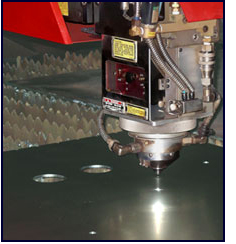We knew from anecdotes that SCS was lasering faster than P&O or hot rolled black, but did not have hard facts to state how much faster or how to reliably achieve these improvements. Now we have both.
|
|||||||||||||
 Speeds for cutting single SCS sheets can be increased by following the new SCS Laser Guidelines. |
Systematic Tests Yield Valuable Laser Guidelines Recently, a manufacturer who lasers SCS sheets enlisted the help of Don Vines, an expert consultant who starts up new laser operations and trains operators. Don was helping optimize their laser throughput by determining appropriate settings for lasering SCS (the company had still been using their settings for P&O). Don began by putting the laser back to the OEM's recommended settings (power, nozzle size, gas, focus) and made sure the resonator was in top shape. He then started cutting 11 gauge sheets of SCS, increasing speed until the laser quit cutting. He then increased nozzle size only, leaving focus and power unchanged. More sheets were cut while gradually increasing speed. The process was repeated until a maximum speed was attained that produced clean, high-quality cuts. Vines checked sensitivities to other laser parameters, but saw no real improvement in this top speed before he ran out of SCS sheets. The speed Vines reached? 5500 mm/minute! Vines exclaimed, "This is amazing! I have NEVER seen any steel laser this fast. And since this customer was lasering their P&O at a top speed of 2200 mm/min., they have more than doubled their speed with SCS." |
||||||||||||
|
Don Vines codified his experience into a step-by-step procedure for optimizing laser speed with SCS. That procedure is now available for downloading through this link: Laser Recommendations. Note that Vines' tests were carried out using oxygen as the resonator gas. He is anxious to repeat his test with nitrogen, as nitrogen is popular because it prevents oxidation around the contoured part cut. The Reason for Speed Improvements The characteristic cleanliness of SCS appears to be the chief reason why it lasers so much faster than P&O, hot roll black and temper pass. With no oil smoke to fog up the laser lens, no grit or dirt to cause beam deflection or dispersion, SCS allows the laser head to operate consistently on spec. Help For Your Laser Optimization Can other fabricators expect to see a near doubling of laser speed when switching to SCS? Vines offered this observation: "Some will see that kind of improvement. But many have already worked hard to improve their laser speeds and are running near 4000 mm/minute. Still, even for this group, using SCS should get their speeds for cutting 10 to 12 gauge over 5000 mm/minute - and that's a 25% improvement. They'll jump at that ." Some final good news: Application experts are available to assist SCS users with optimizing their laser cutting performance. If you'd like to enlist their help, contact your SCS supplier to arrange for a consultation. |
|||||||||||||
